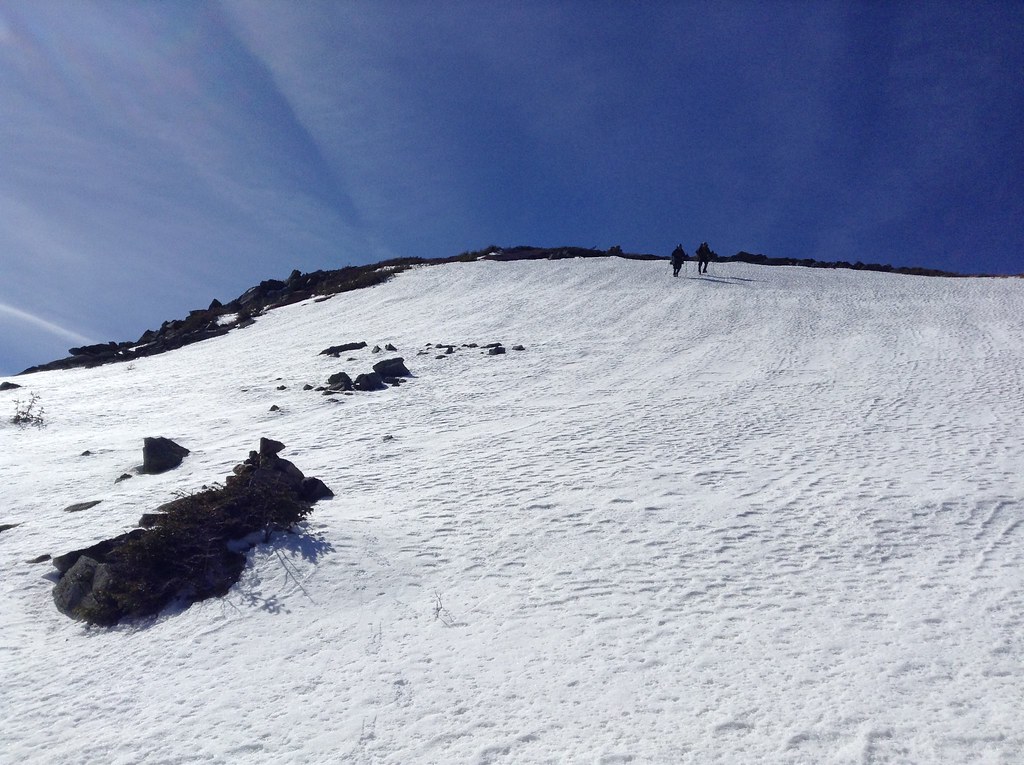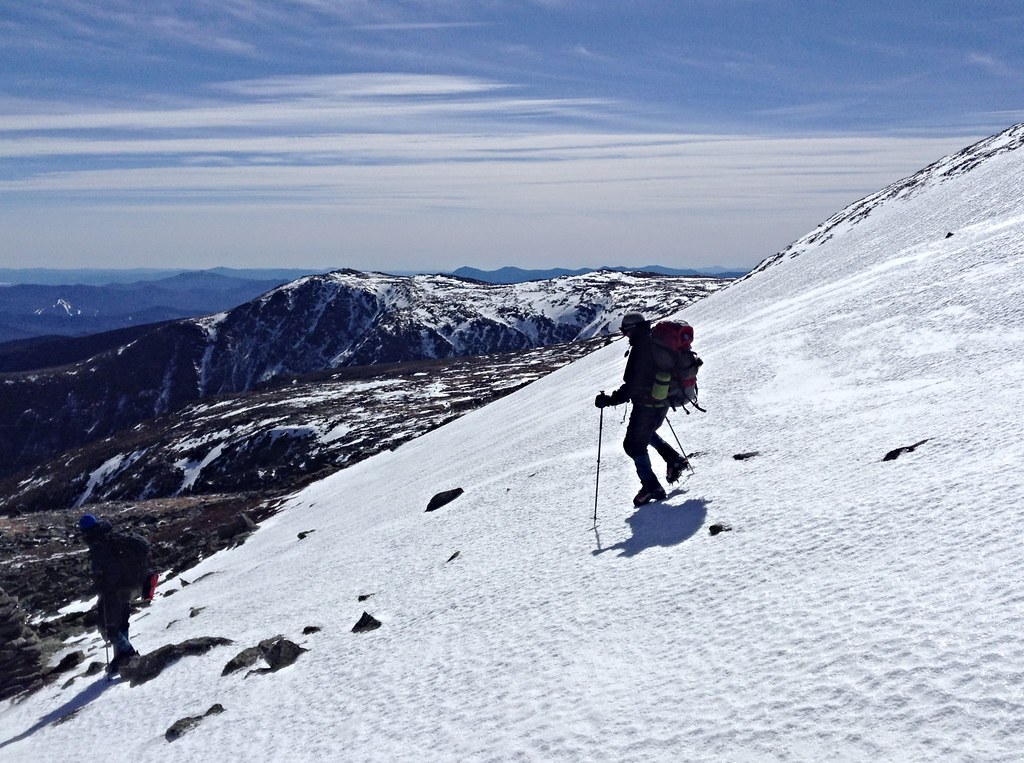
“A climber fell into the gorge earlier this week,” my uncle said as we stood at the edge of Flume Gorge in New Hampshire’s Franconia Notch.
“He fell in?” I said.
“The guide said that a kid was walking to the climbing area, slipped on the ice, and slid down into the water.”
“He must have fallen 15 feet! That water is freezing. Surprised he didn’t drown.”
“Broke his arm. They had to do an emergency rescue.”
Ice climbing can be dangerous. Even more dangerous, as I found in mid-March, is ice climbing when the weather is warm and the ice is rapidly melting and creating rushing pools of water through an area like Flume Gorge. Uncle Steve, his son Aidan, and I were there for our first-ever ice climbing session as part of what’s become an annual winter pilgrimage to the White Mountains.
Because of the mild winter, I think we were climbing on the last day with half-decent ice. Throughout the previous week, according to our guides from Rock Spot climbing gym, the Gorge’s ice waterfalls and ice dams had been crashing down the sides of the Gorge, leaving us with just one small section on which to climb. Here’s a pic of Steve (in black) in the Gorge:
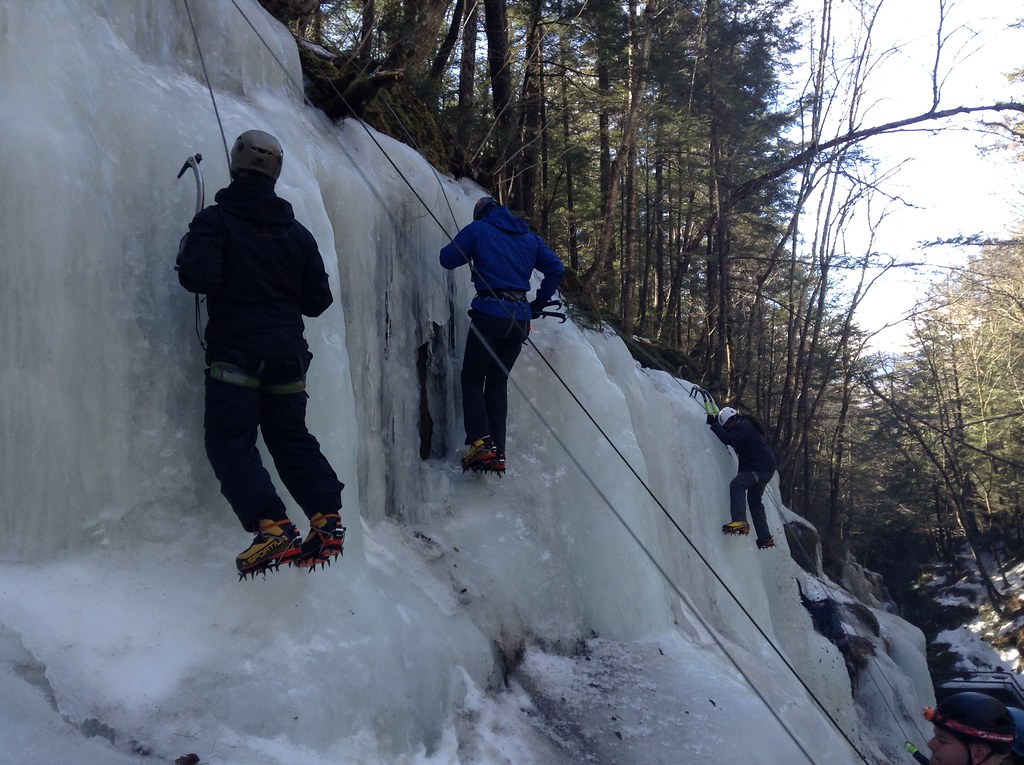
For a few years I’ve been into rock climbing, but the idea of ice climbing never really appealed to me. It looks so cold: the shivering belayer is standing stagnant at the bottom of an ice wall, teeth-chattering, as he holds a rope for a climber who, armed with clawed-boots and ice picks, hacks his way up an ice wall, wondering all the while whether the entire thing will crumble or collapse. It seems like such a struggle, so brute and inelegant, whereas rock climbing on a warm day is so relaxing, peaceful, and more zen-like in the actual climb as you discover how the rock will allow you to climb it.
Don’t knock it ’til you try it. I tried it, and while I’m still knocking it, I can better see the utility in knowing how to ice climb. It’s not so much a pursuit in itself (like rock climbing, for me) but a tool while in pursuit of an icy summit. Here’s Aidan in blue:

That was all on Friday. The next day we planned to go east over to Mt. Washington and spend a night on the mountain. First we drove across the Kancamagus Highway to North Conway to the mountaineering shop IME, where the legendary owner Rick Wilcox helped Aidan find a newish pair of second-hand winter hiking boots from the bargain basement. Before we left, Rick’s wife advised we bring crampons because two weeks earlier a mountaineering guide made the mistake while hiking solo of thinking he only needed microspikes on the Castle Ravine Trail near Mount Jefferson; the guy slipped, fell, broke both legs, and froze to death.
“We’ll definitely wear our crampons,” I told Rick’s wife.
Onward to Mt. Washington. We parked in the lot of Joe Dodge Lodge in Pinkham Notch, which was packed with all the spring skiers who had come to take advantage of the remaining snow in Tuckerman Ravine.
The idea was to hike up to Harvard Cabin and stay a night there in the company of the energetic and entertaining caretakers Rich and Marcia. We enjoyed their company last year during two nights at Harvard Cabin. In my blog about the experience I wrote that “Rich loves to mock hikers who are ill-versed in the language of mountaineering.” A year later, Rich personally replied with a comment on this very blog! He wrote:
Great trip report. One point of clarification….
I don’t “mock” hikers. I just show them how much I “care” and they “take” it. That is the care-taker relationship. In all honesty, I keep track of users staying the cabin, so the differentiation is needed in case folks don’t return. The distinction between climbing vs hiking lets the caretaker no where people are venturing in case we have empty sleeping bags later in the day.
Time to get back up the hill. See you soon.
Cool guy. Unfortunately, Harvard Cabin was totally full when we tried to stay there March 12. Our back-up option was to stay at the unheated Hermit Lake Shelters about 1.5 miles away at Tuckerman Ravine. Problem was, because we’d planned to stay at Harvard and use its gas stove, we hadn’t bothered to bring a portable camp stove. We decided to make-do by filling my 1.5-liter thermos with boiling water from Joe Dodge Lodge’s kitchen, which seemed just enough for preparing a dinner of instant noodle soup.
I also brought my snowblades — 90s-era short skis whose bindings are compatible with mountaineering boots.
We started up the Tuckerman Ravine Trail, then turned onto the less-traversed and more-scenic Raymond Path, which connected us with the Huntington Ravine Trail. The weather was mild: 40s, sunny, little wind. Under the load of our 35-pound packs, we quickly got sweaty. I was soon wearing only a t-shirt. Up in Huntington Ravine, we spotted a few groups of ice climbers creeping up its infamous gullies. We agreed that it could be cool to next year try ice climbing in Huntington with a guide (maybe Rich hires out?).

We hiked out of the Ravine and connected back onto the Tuckerman Ravine Trail to the Hermit Lake Shelters, where we secured space on the floor of one of the few wooden refuges with a sliding front door (most are open shelters). We dropped our bags and hiked up into Tuckerman Ravine, arriving into the bowl at about 4:30pm. All the skiers had left, and for good reason: By now, the bowl had been in the shadows for more than an hour, and the snow had turned to concrete.
But I’d be damned if I was going to miss my only chance to ski Tuckerman this season. I hiked alone up the Right Gully and strapped on my blades. It was terrifying. Snowblades (also called skiboards) are so short that they don’t offer much of an edge to grab the snow, and as there wasn’t even snow, only bullet-proof ice, I had no traction. I was standing on a mountain of ice. Here’s a painful video of me attempting to get down without killing myself:
Aidan later said that watching me attempt this “ski” down Tuckerman was a highlight of his weekend. Ha ha ha. The very next day, on a less-steep area called Hillman’s Highway, a skier would lose control and slide down 1000 feet, hitting several rocks and sustaining “serious injuries requiring immediate evacuation” by emergency helicopter, according to an accident report from the Mount Washington Avalanche Center.
Back at Hermit Lake, we befriended the others staying in our shelter. One of them was an intense ski-mountaineer named Nicole who, it turned out through the evening’s conversation, had recently had her heart broken by the hut caretaker over at Gray Knob in the Northern Presidentials. It’s like an episode of The Young and the Restless up there! (Side note: I forgot Nicole’s name until I looked up the most popular baby names in the 1980s. Nicole was #8 and Stephen was #37. Both our names have drastically dropped off in popularity in the 21st century.)
Nicole sat with us on the shelter’s wooden floor as we ate our dinner of super-sharp cheddar, saucisson (cured meat log), and instant noodle soup (having just enough hot water from my thermos for our three bowls). The next morning, with hot water donated from Nicole and the Hermit Lake caretaker, we had instant oatmeal and instant coffee.
Now Sunday, we decided to climb the Lion Head Summer Trail to the summit of Washington. It was warm in the trees, but as soon as we emerged above tree-line we encountered Washington’s typical howling wind.
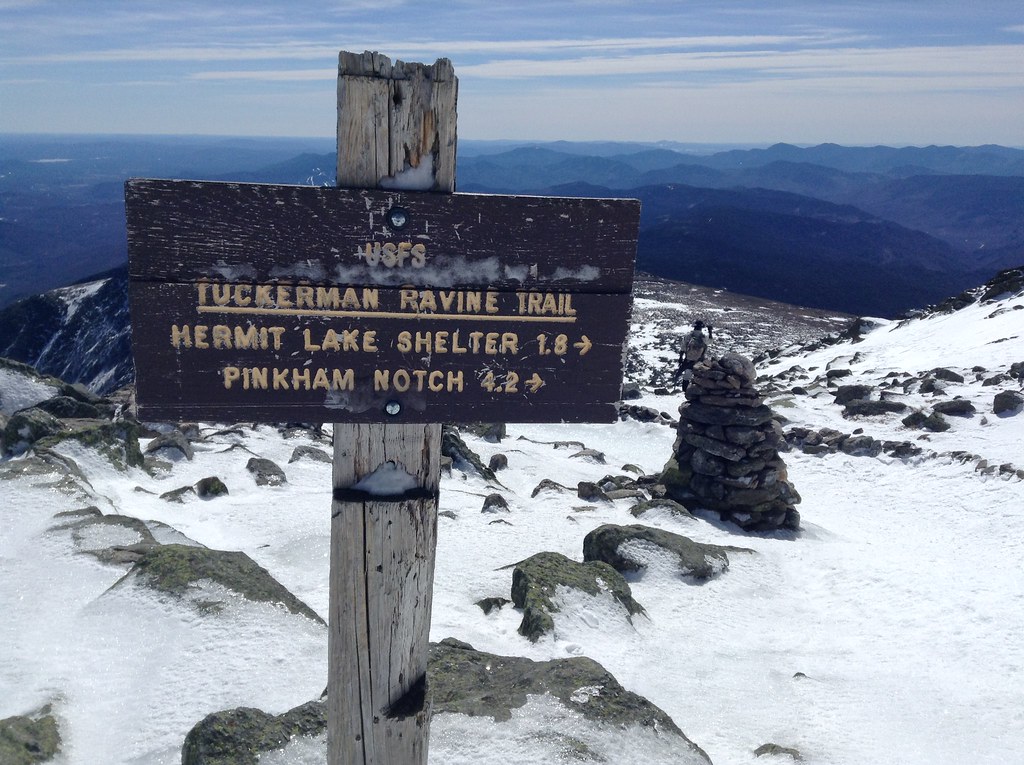
According to data from the Mount Washington Observatory summit weather station, on March 13 the average wind speed was 51 mph, with a peak gust of 109 mph — and we surely felt the upper end of that. The temperature was around 31 degrees F when we summited, which translated to a wind chill of 7-13 degree F.
The wind was so intense that, when I attempted to look back to check on Aidan and Uncle Steve, I was blown off balance and sideways. We were repeatedly ducking behind boulders to rest from the hurricane-force winds. Very intimidating.
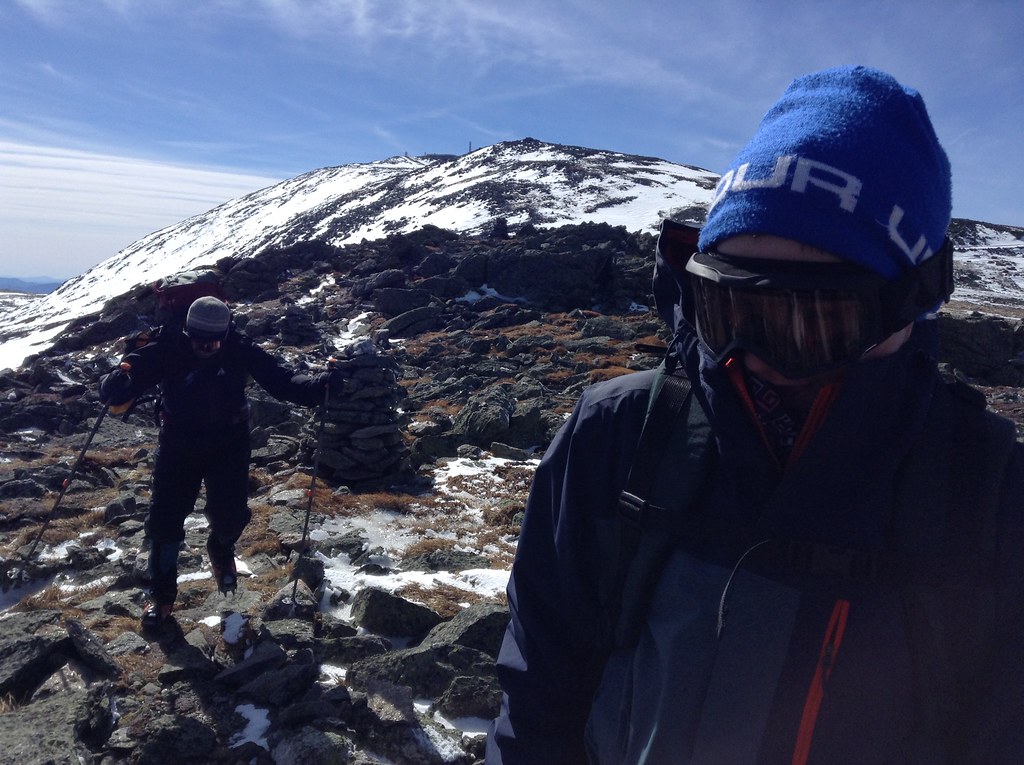
As we approached the summit, we heard a thundering sound: an emergency rescue helicopter zooming in from the north and circling around Tuckerman Ravine. It was the rescue chopper for the aforementioned skier who fell down Hillman’s Highway.
But that wasn’t the only accident of the day. Around the same time that we were descending the snowfields of the summit cone, another group of three hikers got into trouble near the Alpine Garden/ Lion Head Junction (where we’d been earlier) when one of them broke his femur during a glissade that turned into an out-of-control slide. The guy was stranded for more than five hours before another rescue helicopter could get him off the mountain, according to the accident report.
Of note: The guy who broke his femur wasn’t wearing crampons, nor was that hiking guide who had frozen to death on Mount Jefferson just two weeks earlier, and nor was the kid who slid into Flume Gorge and broke his arm. We were. Which is certainly one reason why we got home safely (after some scary glissading of our own down the lower Nelson Crag Trail.
